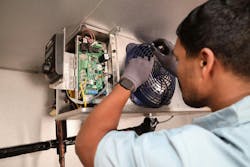Silence the Leak: Smart Detection Reshapes Commercial Refrigeration
Refrigerant leaks often begin subtly. An undetected pinhole can lead to significant product loss, operational downtime and regulatory penalties. The environmental cost of escaped refrigerants further amplifies this issue.
Automatic Leak Detection Systems (ALDS) are becoming fundamental infrastructure in facilities relying on mechanical cooling.
Refrigerant leaks pose three primary risks: environmental harm, operational expense, and regulatory noncompliance. Many refrigerants have high global warming potential (GWP), and preventing these leaks directly supports climate protection. Operational costs include system recharging, spoiled goods, and emergency service. Regulatory bodies worldwide impose strict standards for leak repair and compliance. Noncompliance can result in substantial fines.
A critical aspect of this shift involves the move to A2L refrigerants. These refrigerants, while beneficial for the climate, are mildly flammable. Consequently, industry standards and building codes now often require ALDS use in many systems above specific charge sizes or installation types.
An ALDS consists of sensors that continuously monitor the air for refrigerant traces. Unlike manual checks, ALDS offers constant vigilance alerting before a small leak escalates.
Common detection technologies include:
- Infrared (IR): Detects refrigerants by measuring light absorption at specific wavelengths. These sensors are stable and highly selective;
- Electrochemical: Used for ammonia or hydrocarbon refrigerants. They generate electrical signals from chemical reactions with the gas.
- Ultrasonic: Identifies the high-frequency sound of gas escaping under pressure. This method detects the act of leaking rather than the refrigerant itself; and
- Semiconductor (MOS): Provides broad, sensitive detection but can be more susceptible to false alarms from environmental factors.
Some systems combine these methods to enhance accuracy. Most integrate with building or energy management systems to provide alerts, trigger alarms, or initiate shutdown protocols.
For A2L refrigerants, code compliance often necessitates ALDS to also control mechanical ventilation. If a leak is detected, the system must activate airflow to dilute refrigerant concentrations below the lower flammability limit (LFL) to prevent ignition. Effective sensor placement is key. High-risk areas include compressor racks, valve stations, piping transitions, evaporator coils, and mechanical room entrances. Heavier refrigerants settle low, requiring floor-level sensors, while lighter gases rise, needing overhead detection.
A2L refrigerants behave similarly to heavier HFCs. Standards provide specific guidance on sensor placement zones, response times, and minimum detection thresholds. ALDS must automatically trigger ventilation or compressor shutdown if LFLs are approached. Alarm thresholds are carefully set for A2Ls, often lower than for traditional refrigerants.
While upfront costs exist for ALDS systems, the investment offers returns through refrigerant savings, reduced service needs and ensuring compliance and operational approval. Early leak detection can prevent significant refrigerant loss. Precise alarms reduce time spent identifying leaks.
System effectiveness can be compromised by improper sensor placement, false alarms, or lack of maintenance. Technicians must understand refrigerant behavior for optimal sensor positioning. Environmental interference or missed calibration can cause false alarms, leading to “alarm fatigue.” Sensors degrade over time, requiring regular recalibration or replacement.
Leak detection systems have advanced as refrigeration systems become more complex and regulations evolve. Cloud-based platforms allow centralized monitoring, and artificial intelligence helps differentiate true alarms from false ones. Some systems even predict leak risks using operational data. The rise of A2Ls accelerates this evolution, making smart ALDS a code-enforced requirement demanding sensitivity, speed, documentation and certification.
Refrigerant leaks are often silent. A robust ALDS ensures your system communicates these issues, preventing product loss, equipment damage, or operational disruption. Investing in a reliable code-compliant ALDS is crucial.
About the Author
Chris Thomas
Chris Thomas is the supervisor of Product Services at Heatcraft Refrigeration Products.
